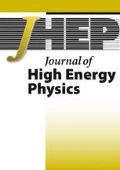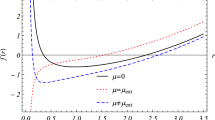Abstract
In this paper we treat the black hole horizon as a physical boundary to the spacetime and study its dynamics following from the Gibbons-Hawking-York boundary term. Using the Kerr black hole as an example we derive an effective action that describes, in the large wave number limit, a massless Klein-Gordon field living on the average location of the boundary. Complete solutions can be found in the small rotation limit of the black hole. The formulation suggests that the boundary can be treated in the same way as any other matter contributions. In particular, the angular momentum of the boundary matches exactly with that of the black hole, suggesting an interesting possibility that all charges (including the entropy) of the black hole are carried by the boundary. Using this as input, we derive predictions on the Planck scale properties of the boundary.
Similar content being viewed by others
References
G. ’t Hooft, Dimensional reduction in quantum gravity, gr-qc/9310026 [INSPIRE].
L. Susskind, The world as a hologram, J. Math. Phys. 36 (1995) 6377 [hep-th/9409089] [INSPIRE].
R. Bousso, The holographic principle, Rev. Mod. Phys. 74 (2002) 825 [hep-th/0203101] [INSPIRE].
J.D. Brown and M. Henneaux, Central charges in the canonical realization of asymptotic symmetries: an example from three-dimensional gravity, Commun. Math. Phys. 104 (1986) 207 [INSPIRE].
J.M. Maldacena, The large-N limit of superconformal field theories and supergravity, Adv. Theor. Math. Phys. 2 (1998) 231 [Int. J. Theor. Phys. 38 (1999) 1113] [hep-th/9711200] [INSPIRE].
S. Gubser, I.R. Klebanov and A.M. Polyakov, Gauge theory correlators from noncritical string theory, Phys. Lett. B 428 (1998) 105 [hep-th/9802109] [INSPIRE].
E. Witten, Anti-de Sitter space and holography, Adv. Theor. Math. Phys. 2 (1998) 253 [hep-th/9802150] [INSPIRE].
A. Strominger and C. Vafa, Microscopic origin of the Bekenstein-Hawking entropy, Phys. Lett. B 379 (1996) 99 [hep-th/9601029] [INSPIRE].
A. Strominger, Black hole entropy from near horizon microstates, JHEP 02 (1998) 009 [hep-th/9712251] [INSPIRE].
S. Carlip, Black hole entropy from conformal field theory in any dimension, Phys. Rev. Lett. 82 (1999) 2828 [hep-th/9812013] [INSPIRE].
M. Guica, T. Hartman, W. Song and A. Strominger, The Kerr/CFT correspondence, Phys. Rev. D 80 (2009) 124008 [arXiv:0809.4266] [INSPIRE].
A. Castro, A. Maloney and A. Strominger, Hidden conformal symmetry of the Kerr black hole, Phys. Rev. D 82 (2010) 024008 [arXiv:1004.0996] [INSPIRE].
O. Aharony, S.S. Gubser, J.M. Maldacena, H. Ooguri and Y. Oz, Large-N field theories, string theory and gravity, Phys. Rept. 323 (2000) 183 [hep-th/9905111] [INSPIRE].
G. Policastro, D. Son and A. Starinets, The shear viscosity of strongly coupled N = 4 supersymmetric Yang-Mills plasma, Phys. Rev. Lett. 87 (2001) 081601 [hep-th/0104066] [INSPIRE].
G. Policastro, D.T. Son and A.O. Starinets, From AdS/CFT correspondence to hydrodynamics, JHEP 09 (2002) 043 [hep-th/0205052] [INSPIRE].
S. Ryu and T. Takayanagi, Holographic derivation of entanglement entropy from AdS/CFT, Phys. Rev. Lett. 96 (2006) 181602 [hep-th/0603001] [INSPIRE].
S.A. Hartnoll, Lectures on holographic methods for condensed matter physics, Class. Quant. Grav. 26 (2009) 224002 [arXiv:0903.3246] [INSPIRE].
G. ’t Hooft, On the quantum structure of a black hole, Nucl. Phys. B 256 (1985) 727 [INSPIRE].
M. Arzano, S. Bianco and O. Dreyer, From bricks to quasinormal modes: a new perspective on black hole entropy, arXiv:1305.3479 [INSPIRE].
J.W. York, Dynamical origin of black hole radiance, Phys. Rev. D 28 (1983) 2929 [INSPIRE].
M. Parikh and F. Wilczek, An action for black hole membranes, Phys. Rev. D 58 (1998) 064011 [gr-qc/9712077] [INSPIRE].
K.S. Thorne, R.H. Price and D.A. Macdonald, Black holes: the membrane paradigm, Yale University Press, London U.K. (1986).
J.P. Lemos and O.B. Zaslavskii, Membrane paradigm and entropy of black holes in the Euclidean action approach, Phys. Rev. D 84 (2011) 064017 [arXiv:1108.1801] [INSPIRE].
S. Carlip, Dynamics of asymptotic diffeomorphisms in (2 + 1)-dimensional gravity, Class. Quant. Grav. 22 (2005) 3055 [gr-qc/0501033] [INSPIRE].
H. Lü, J. Mei and C. Pope, Kerr/CFT correspondence in diverse dimensions, JHEP 04 (2009) 054 [arXiv:0811.2225] [INSPIRE].
D.D. Chow, M. Cvetič, H. Lü and C. Pope, Extremal black hole/CFT correspondence in (gauged) supergravities, Phys. Rev. D 79 (2009) 084018 [arXiv:0812.2918] [INSPIRE].
J. Mei, The entropy for general extremal black holes, JHEP 04 (2010) 005 [arXiv:1002.1349] [INSPIRE].
J. Mei, Conformal symmetries of the Einstein-Hilbert action on horizons of stationary and axisymmetric black holes, Class. Quant. Grav. 29 (2012) 095020 [arXiv:1108.3841] [INSPIRE].
S. Carlip, Extremal and nonextremal Kerr/CFT correspondences, JHEP 04 (2011) 076 [Erratum ibid. 01 (2012) 008] [arXiv:1101.5136] [INSPIRE].
J. Mei, On the general Kerr/CFT correspondence in arbitrary dimensions, JHEP 04 (2012) 113 [arXiv:1202.4156] [INSPIRE].
S. Carlip, Symmetries, horizons and black hole entropy, Gen. Rel. Grav. 39 (2007) 1519 [Int. J. Mod. Phys. D 17 (2008) 659] [arXiv:0705.3024] [INSPIRE].
S.L. Braunstein, S. Pirandola and K. Życzkowski, Entangled black holes as ciphers of hidden information, Phys. Rev. Lett. 110 (2013) 101301 [arXiv:0907.1190] [INSPIRE].
A. Almheiri, D. Marolf, J. Polchinski and J. Sully, Black holes: complementarity or firewalls?, JHEP 02 (2013) 062 [arXiv:1207.3123] [INSPIRE].
S.N. Solodukhin, Entanglement entropy of black holes, Living Rev. Rel. 14 (2011) 8 [arXiv:1104.3712] [INSPIRE].
J.W. York, Role of conformal three geometry in the dynamics of gravitation, Phys. Rev. Lett. 28 (1972) 1082 [INSPIRE].
G. Gibbons and S. Hawking, Action integrals and partition functions in quantum gravity, Phys. Rev. D 15 (1977) 2752 [INSPIRE].
J.D. Brown and J.W. York, Quasilocal energy and conserved charges derived from the gravitational action, Phys. Rev. D 47 (1993) 1407 [gr-qc/9209012] [INSPIRE].
A. Sen, Black hole entropy function, attractors and precision counting of microstates, Gen. Rel. Grav. 40 (2008) 2249 [arXiv:0708.1270] [INSPIRE].
Author information
Authors and Affiliations
Corresponding author
Rights and permissions
About this article
Cite this article
Mei, J. Fluctuating black hole horizons. J. High Energ. Phys. 2013, 195 (2013). https://doi.org/10.1007/JHEP10(2013)195
Received:
Revised:
Accepted:
Published:
DOI: https://doi.org/10.1007/JHEP10(2013)195




